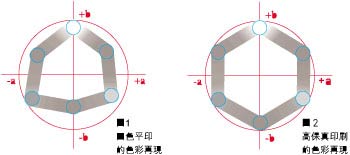The key technologies in achieving high-fidelity printing include hi-fi color printing with rgb ink in cmyk inks; high-precision screening using 350 lines per inch with the number of internet lines; and the size of dots that do not use dots. Instead, the dots are arranged irregularly at a spot size of 20 μm, and the depth of FM screening is expressed by the degree of dot condensation. The two methods of high-precision screening and FM screening are as much as possible to narrow the dots to the eye's invisible level, so that the details of the picture can be reproduced. The FM screening method has the advantages of eliminating the interference of the mesh and the picture, improving the resolution of the image, and avoiding the occurrence of moiré between the pattern base and the mesh, and has the advantage of being able to achieve a more natural printing performance. In contrast, high-fidelity printing is a method in which rgb ink is added to a 4-color plate-making ink, and the color space that can be expressed during printing can be expanded, thereby improving the quality of print color reproduction. This article is based on high-fidelity printing. Regarding its technical and application advantages, it introduces the software erer multi color separation (eder-mcs) recommended by Heidelberg in Japan. What is the so-called high-fidelity printing? For high-fidelity printing, the ability to perform 5-8 color separations for ordinary color originals is the most important feature. For the 4 color printing of cmyk, the plate-making inks have imprecise spectral characteristics. The turbidity of the secondary color (rgb) is generated, and it is replaced with a bright color rgb ink to achieve a color reproduction that is closer to the primary color. This printing method is called hi-fi color printing. When the two colors of ink are superimposed together, because each color of ink has spectral characteristics that contain unwanted noise, the resulting secondary color saturation is reduced, which is currently the limit for subtractive mixing from cmyk inks. The practice of replacing the secondary color with a high saturation color ink is the logic of high-fidelity printing. For the printed matter on the packaging of the product, the important color of the package and the registered trademark of the manufacturer are printed in the spot color ink. This is the spot color processing method. However, the difference between high-fidelity printing and spot-color printing is that compensation for the saturation of the secondary color is its purpose. There is no direct assistance for specific colors in the picture. Second, the characteristics of high-fidelity printing The increase in the number of color ink species, because of the narrower spectral width of the ink, even if the printing density of other cmy ink changes, it will not directly affect the overall color balance and gray balance . Therefore, the secondary and tertiary colors are stable during the printing process. In the case of spot colors, the number of colors required for a certain number of color inks, and high-fidelity printing conditions can only add black ink, and 7 colors can achieve all color reproduction. Moreover, if the color document does not contain all the colors, the number of colors can be reduced to 5 colors or 6 colors, and the reproducibility of the desired color can also be improved by changing the saturation and hue of the rgb ink. The advantages of the above high-fidelity printing methods are summarized as follows: Raise the saturation of secondary colors (r, g, b) (no limit color); In the printing process, the secondary and tertiary colors remain stable; Do only select rgb inks that are effective for drawing; Use the picture to select the saturation and hue of the rgb ink. Third, high-fidelity printing color space In four-color lithography, red, green, and blue colors are overprinted with cmy ink. The saturation of the secondary color rgb is dependent on the characteristics of the four color inks, and as is generally indicated by the cielab color space of FIG. 1, the saturation of the color is reduced to appear turbid. If you use an ink that only holds the rgb color gamut, you can reproduce that part of the color vividly. High-fidelity printing is shown in Fig. 2. In the direction of the color to be expressed, the ink of the corresponding hue can be used to expand the color space arbitrarily. Fourth, high-fidelity print color reproduction In order to achieve high-fidelity printing, there are several technologies available for selection. Multi color separation (multi color separation); Gcr(gray component replacement); FM screening; High-fidelity printing with color proofing; Automatic adjustment of the amount of ink; Automatic printing registration. According to the above technology, the effect of multi-color lithography can be improved to obtain stable and high-quality prints: Multi color separation The software eder mcs multicolor color separation system is an application software that works on the power macintosh. The images taken by scanners and digital cameras (tiff-cmyk or eps format) are loaded into eder mcs, and 5-8 colors are implemented. Separation. Regarding its function, leave it to the back. (to be continued) Leisure Chair,Lounge Chair That Lays Flat,Outdoor Leisure Chair,Comfortable Leisure Chair Foshan Poesy Furniture Co., LTD. , https://www.poesy-furniture.com